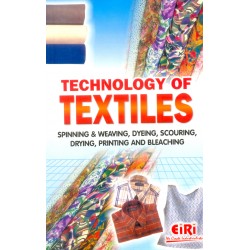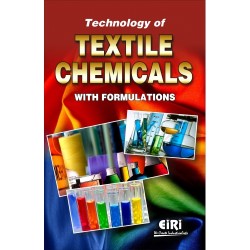Detailed Project Report on textile bleaching, dyeing, finishing & printing

- More than 40 years of experience
- Managed by expert industrial consultants
- ISO 9001-2015 Certified
- Registered under MSME, UAM No: DL01E0012000
- 24/5 Research Support
Get your quesries resolved from an industry expert. Ask your queries before report or book purchase. - Custom Research Service
Speak to the our consultant to design an exclusive study to serve your research needs. - Quality Assurance
All reports are prepared by highly qualified consultants & verified by a panel of experts. - Information Security
Your personal & confidential information is safe & secure.
TEXTILE BLEACHING, DYEING, FINISHING & PRINTING
[CODE NO. 2072]
The bleaching of the textile is done to bring the whiteness and finishing in the fabric where as dyeing for various shades. The art lies in colouring the textiles in such a manner that the colour may be fast or may not ordinarily be removed by such operations as washing, rubbing, sunlight etc. to which the textile are usually subjected.
The art of dyeing is a branch of applied chemistry in which a severe use of both physical and chemical principle is made in order to bring about a permanent union between the dyes and the fibres.
True dyeing can only take place when the dyeing is in solution and /or finally divided or dispersed colloidal condition and the fibers are subjected to this dye in solution condition and then this dye being rendered insoluble or fixed by some means, when absorbed upon or within the fibers, or can be direct contact with the fibers. There must exist some marked physico-chemical affinity between the fibers and the dye which would naturally depend upon the respective properties of both.
The local application of colour is carried out by some form of printing, and the greater part of textile printing concerns woven cotton piece goods, the process is sometimes called calico printing, at the same time it must be released that very considerable quantities of rayon’s are printed as well as small amounts of silk and wool.
The organmentation of the fabric by printing coloured designs falls into two broad classes, in the first, there is a colored design or pattern on a white background, whereas in the second , the background is colored and carries a white design or a pattern of a different colour or shade. In accordance with these effects, the print is classified by its style, this term does not mean the design or the chemical process, it simply refers to the produced by the direct application of the colour to the fabric. In the direct style, the suitably thickened colour is applied directly to the cloth by printing, a variation of the direct style is to print the cloth directly with a mordant and then dye the material, when the unprinted portion will remain uncoloured.
The resist style, as its name implies, comes from printing the material with a substance which will resist dyeing later and hence produce a pattern on a coloured ground. The discharge style depends on dyeing the fabric first and then removing the colour in selected areas i.e. descharging it is the discharging medium may also contain another colour which does not discharge, and in this manner it replaces, the colour originally situated on the fabric.
The term finishing in its widest sense has been held to cover all the processes which fabrics undergo after eaving the loan or knitting machine, from this stand point, finishing would include bleaching, and dyeing, which, indeed, are some times regarded as wet finishing, processes.
The object of finishing is to improve the attractiveness and /or serviceability of the fabric. A more restricted view of finishing is that of the third and final stage of the treatment of woven or knitted fabrics to prepare them for the consumer, bleaching a colouring from the fist and seconds stages. Even this definition, however, is open to criticism for some fabrics are not bleached and others are not dyed or printed again, many finishing operations, such as the creeping of silk and rayon, the mercerizing of cotton the crabbing of wool and the cutting of velvets, from part of the first phase of fabric treatment. Subject of these corrections, finishing, is best regarded as the final stage is the embellishing of the fabrics.
The textile dyeing industry consumes large quantities of water and produces large volumes of wastewater from different steps in the dyeing and finishing processes. Wastewater from printing and dyeing units is often rich in color, containing residues of reactive dyes and chemicals, and requires proper treatment before being released into the environment. The toxic effects of dyestuffs and other organic compounds, as well as acidic and alkaline contaminants, from industrial establishments on the general public are widely accepted. Increasing public concern about environmental issues has led to closure of several small-scale industries.
Interest in ecologically friendly, wet-processing textile techniques has increased in recent years because of increased awareness of environmental issues throughout the world. Consumers in developed countries are demanding biodegradable and ecologically friendly textiles. Cotton provides an ecologically friendly textile, but more than 50% of its production volume is dyed with reactive dyes. Unfortunately, dyes are unfavorable from an ecological point of view, because the effluents generated are heavily colored, contain high concentrations of salts, and exhibit high biological oxygen demand/chemical oxygen demand (BOD/COD) values.
In dyeing textiles, ecological standards are strictly applied throughout processing from raw material selection to the final product. This has become more critical since the German environmental standards regarding dye effluents became effective. The main challenge for the textile industry today is to modify production methods, so they are more ecologically friendly at a competitive price, by using safer dyes and chemicals and by reducing cost of effluent treatment/disposal. Recycling has become a necessary element, not because of the shortage of any item, but because of the need to control pollution. There are three ways to reduce pollution: (1) use of new, less polluting technologies; (2) effective treatment of effluent so that it conforms to specified discharge requirements; and (3) recycling waste several times over before discharge, which is considered the most practical solution.
COST ESTIMATION
Plant Capacity 5.00 MT./day
Land & Building (4000 Sq.Mtr) Rs.2.10 Cr
Plant & Machinery Rs. 95.00 Lacs
W.C. for 2 Months Rs. 55.00 Lacs
Total Capital Investment Rs. 3.65 Cr
Rate of Return 21%
Break Even Point 61%
• INTRODUCTION
• NEED OF THE FINISHING OF FABRIC
• B.I.S. SPECIFICATION
• MARKET SURVEY
• MAJOR PLAYERS IN TEXTILE INDUSTRY
• MANUFACTURING PROCESS
• DETAILS OF BLEACHING PROCESS
• DETAILS OF DRYING PROCESS
• DETAILS OF DYEING PROCESS
• FINISHING OF CLOTH
• APPLICATION OF SYNTHETIC RESINS
• WATER REPELLENT FINISHING
• FIRE PROOF
• DETAILS OF DIFFERENT TEXTILE OPERATION
• EFFLUENT TREATMENT IN TEXTILE
• MEMBRANE PROCESSES
• PRINCIPLES OF PLANT LAYOUT
• PLANT LOCATION FACTORS
• EXPLANATION OF TERMS USED IN THE PROJECT REPORT
• PROJECT IMPLEMENTATION SCHEDULES
• SUPPLIERS OF PLANT AND MACHINERY
• SUPPLIERS OF RAW MATERILS
APPENDIX – A :
1. COST OF PLANT ECONOMICS
2. LAND & BUILDING
3. PLANT AND MACHINERY
4. FIXED CAPITAL INVESTMENT
5. RAW MATERIAL
6. SALARY AND WAGES
7. UTILITIES AND OVERHEADS
8. TOTAL WORKING CAPITAL
9. COST OF PRODUCTION
10. PROFITABILITY ANALYSIS
11. BREAK EVEN POINT
12. RESOURCES OF FINANCE
13. INTEREST CHART
14. DEPRECIATION CHART
15. CASH FLOW STATEMENT
16. PROJECTED BALANCE SHEET
How to Make Project Report?
Detailed Project Report (DPR) includes Present Market Position and Expected Future Demand, Technology, Manufacturing Process, Investment Opportunity, Plant Economics and Project Financials. comprehensive analysis from industry covering detailed reporting and evaluates the position of the industry by providing insights to the SWOT analysis of the industry.
Each report include Plant Capacity, requirement of Land & Building, Plant & Machinery, Flow Sheet Diagram, Raw Materials detail with suppliers list, Total Capital Investment along with detailed calculation on Rate of Return, Break-Even Analysis and Profitability Analysis. The report also provides a birds eye view of the global industry with details on projected market size and then progresses to evaluate the industry in detail.
We can prepare detailed project report on any industry as per your requirement.
We can also modify the project capacity and project cost as per your requirement. If you are planning to start a business, contact us today.
Detailed Project Report (DPR) gives you access to decisive data such as:
- Market growth drivers
- Factors limiting market growth
- Current market trends
- Market structure
- Key highlights
Overview of key market forces propelling and restraining market growth:
- Up-to-date analyses of market trends and technological improvements
- Pin-point analyses of market competition dynamics to offer you a competitive edge major competitors
- An array of graphics, BEP analysis of major industry segments
- Detailed analyses of industry trends
- A well-defined technological growth with an impact-analysis
- A clear understanding of the competitive landscape and key product segments
Need Customized Project Report?
- Ask for FREE project related details with our consultant/industry expert.
- Share your specific research requirements for customized project report.
- Request for due diligence and consumer centric studies.
- Still haven't found what you're looking for? Speak to our Custom Research Team
About Engineers India Research Institute:
Note: We can also prepare project report on any subject based on your requirement and country. If you need, we can modify the project capacity and project cost based on your requirement.
Our Clients

Our Approach
- Our research reports comprehensively cover Indian markets (can be modified as per your country), present investigation, standpoint and gauge for a time of five years*.
- The market conjectures are produced on the premise of optional research and are cross-accepted through associations with the business players
- We use dependable wellsprings of data and databases. What's more, data from such sources is handled by us and incorporated into the report
Why buy EIRI reports?
- Our project reports include detailed analysis that help to get industry Present Market Position and Expected Future Demand.
- Offer real analysis driving variables for the business and most recent business sector patterns in the business
- This report comprehends the present status of the business by clarifying a complete SWOT examination and investigation of the interest supply circumstance
- Report gives investigation and top to bottom money related correlation of real players/competitors
- The report gives gauges of key parameters which foresees the business execution
























